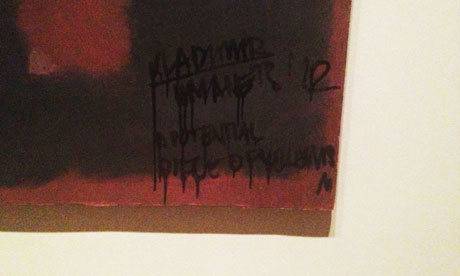Mark Rothko's Seagram murals are great works of art that were given, free, to Britain. They are glories of our artistic heritage – Amarican marvels preserved permanently in London.
Now one has been defaced.
The idiocy of someone scribbling on one of these wine-dark, blood-rich paintings is hideous. Nobody stopped the scoundrel. A witness tweeted that the criminal "tagged" the paining. This was not a tag, which implies a creative act. It was a pathetic assault.
Well, I've got that off my chest.
But why is it always the greatest works of art that get damaged in these ways? Because the Seagram paintings are among the true art treasures of the world. They have a power that expands your mind's eye as you gaze at them. To deface one of these is to deface something with life and magic.
It is a horrible fact that people who for whatever reason feel compelled, in an art gallery, not to stand and look but to scribble, or throw acid, or pull out a hammer, tend to pick the most potent and authoritative works of art for their assaults. It seems there is a psychic force in truly great art that draws the attacker.
In 1987, a man fired a shotgun at Leonardo de Vinci´s Burlington carton in the National Gallery. This is a full-scale design for a painting in which the Virgin Mary sits on the lap of her mother Anne. Mary smiles sweetly; her mother gazes out of cadaverous eyes. The infant Jesus greets a young St John the Baptist. This is an image with great psychological power that speaks intimately of mothers and sons. It fascinated Sigmund Freud: you can see his reproduction of it in his house in north London. He wrote about its maternal aura.
So someone with a confused mind might well find provocations, resonances, that made him choose this of all works of art to blast with a shotgun.
The same deep power emanates from the paintings of Rembrandt. His Danae in the Hermitage in St Petersburgo manages to be about sex and god at the same time. A naked woman in a luxurious bedroom greets a divine numinous visitor. Rembrandt confronts the beholder with the force of desire and the terror of god. In 1985, a man attacked this great painting with sulphuric acid.
Michelangelo's Pieta is another work of art that touches our souls. Here is a young man, dead, in his mother's arms. Michelangelo makes the flesh of Christ's frail body so real and tender in death it is heartbreaking. Once again a transcendent work of art was attacked, this time with a hammmer, in 1972.
Recent art attacks, while mercifully less damaging, have similarly singled out works of true power. Poussin´s Adoration of the Golden Calf is an angry portrayal of false religion. It was defaced. In a perhaps unique incident where the artist expressed pleasure in an illicit response to his work, a woman kissed a Cy Twombly painting and left lipstick on it. For Twombly, that showed how much passion in his art incites.
Rothko, like Rembrandt, like Michelangelo, is an artist who suggests the power of god – or in his case, of god's absence. Attacking him is like attacking fathers, attacking cultural authority. His art will endure, however, as the truth endures.




No comments:
Post a Comment